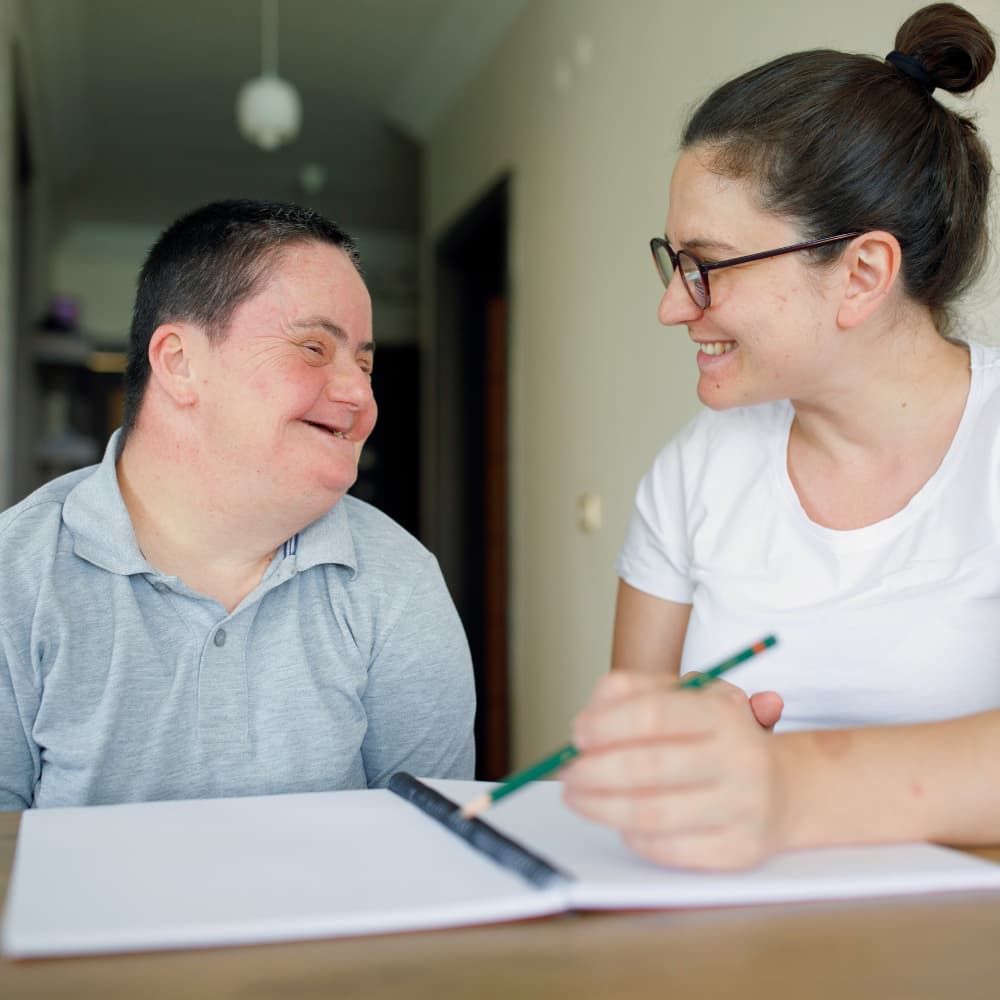Build Skills You Can Use Right Away
This course helps you: - Spot sensory processing differences that affect everyday participation - Understand sensory systems and their role in behaviour, learning, and regulation - Adapt the environment and tasks to meet sensory needs - Use practical tools to identify barriers and support meaningful engagement - Think through a sensory-informed lens using the Person-Environment-Occupation (PEO) model
.jpg)
On-Demand Content
Learn at your own pace via interactive micro-lessons, fit study around your schedule
.png)
Learn From Case Studies
Download a suite of case studies covering people across the life span and in diverse settings
%20(1).jpg)
Downloadable Tools
Keep handouts, tools and guides for future reference
%20(3).jpg)
Tutor Support
Friendly, expert help from Advanced Sensory Integration Practitioners is a click away
%20(1).jpg)
60 Days Access
Plenty of time to work through the course and revisit content - course content is downloadable too
%20(1).jpg)
Certificate of Completion
For your CPD records
Designed for Health and Care Professionals
If you support people of any age who struggle with everyday tasks, this course is for you. Perfect for: - Nurses, Social Workers, and Support Workers - Allied Health Professionals and Assistant Therapists - Social Prescribers - Early career professionals and experienced practitioners alike No prior sensory training required.
Ready to Make a Difference?
Enrol now and start seeing the world through a new sensory lens.
Want To Go Further?
This course is also your first step towards becoming a Certified Sensory Inclusion Facilitator. Complete this course and then upgrade with an online assessment and live workshop to earn your certification. Eligible professionals can use this as a stepping stone towards a university-accredited postgraduate qualification in Sensory Integration.

Developed By Our Expert Therapists
This Signature Series course has been expertly developed by our team of highly experienced occupational therapists who are advanced practitioners in sensory integration. With decades of experience across public and private sector healthcare, schools, and community settings, they bring a wealth of practical knowledge and evidence-based strategies to support your learning. Their expertise ensures the course is grounded in real-world practice, empowering you to make meaningful changes in your professional or personal settings.
The syllabus
-
1
Welcome
-
(Included in full purchase)
How to Use This Course
-
(Included in full purchase)
-
2
Part 1: Introduction to the Sensory Systems
-
(Included in full purchase)
1.0 Introduction to the Sensory Systems and Sensory Differences
-
(Included in full purchase)
1.1 What is Sensory Processing and Integration?
-
(Included in full purchase)
1.2 Introducing the 8 Senses
-
(Included in full purchase)
1.3 The Visual System
-
(Included in full purchase)
1.4 The Auditory System
-
(Included in full purchase)
1.5 The Tactile System
-
(Included in full purchase)
1.6 The Olfactory System
-
(Included in full purchase)
1.7 The Gustatory System
-
(Included in full purchase)
1.8 The Proprioceptive System
-
(Included in full purchase)
1.9 The Vestibular System
-
(Included in full purchase)
1.10 The Interoceptive System
-
(Included in full purchase)
1.11 Ayres Sensory Integration Theory and Practice
-
(Included in full purchase)
1.12 What Are Sensory Processing Differences?
-
(Included in full purchase)
1.13 Sensory Modulation Differences
-
(Included in full purchase)
1.14 Sensory Discrimination Differences
-
(Included in full purchase)
1.15 Activity
-
(Included in full purchase)
-
3
Part 2: Sensory Perception, Discrimination and Motor Skills
-
(Included in full purchase)
2.0 Sensory Perception, Discrimination and Motor Skills
-
(Included in full purchase)
2.1 Sensory Perception and Discrimination
-
(Included in full purchase)
2.2 Posture and Postural Control
-
(Included in full purchase)
2.3 Body Scheme / Body Awareness
-
(Included in full purchase)
2.4 Ocular Motor Control
-
(Included in full purchase)
2.6 Praxis
-
(Included in full purchase)
2.7 Activity, Discussions and Questions
-
(Included in full purchase)
-
4
Part 3: Introduction to the Neurology of Sensory Integration and Processing
-
(Included in full purchase)
3.0 Sensory Responsivity and Regulation
-
(Included in full purchase)
3.1 Sensory Responsivity
-
(Included in full purchase)
3.2 How Sensory Messages Get to the Central Nervous System
-
(Included in full purchase)
3.3 Introducing Sensory Thresholds
-
(Included in full purchase)
3.4 Regulation
-
(Included in full purchase)
3.5 The Autonomic Nervous System and Regulation
-
(Included in full purchase)
3.6 The Reticular Formation and Regulation
-
(Included in full purchase)
3.7 The Thalamus and Regulation
-
(Included in full purchase)
3.8 The Limbic System and Regulation
-
(Included in full purchase)
3.9 Reflective Activity: Listening to Your Body
-
(Included in full purchase)
-
5
Part 4: Person
-
(Included in full purchase)
4.0 Person
-
(Included in full purchase)
4.1 Introduction to the PEO Model
-
(Included in full purchase)
4.2 Reframing Behaviour Through a Sensory Lens
-
(Included in full purchase)
4.3 Preparation for Assessment
-
(Included in full purchase)
4.4 The Importance of Meaningful Goal Setting in Sensory Interventions
-
(Included in full purchase)
4.5 ASI Practitioners' Sensory Questionnaires
-
(Included in full purchase)
4.6 SIE Sensory Insight Questionnaire
-
(Included in full purchase)
4.7 SIE Sensory Motor Skills Observations
-
(Included in full purchase)
4.8 MYSET: My Sensory Experiences Tool
-
(Included in full purchase)
4.9 Considerations
-
(Included in full purchase)
4.10 Interpreting Data, Feeding Back and Celebrating Strengths
-
(Included in full purchase)
4.11 Person Interventions
-
(Included in full purchase)
4.12 Supporting Dyspraxia
-
(Included in full purchase)
4.13 Regulation Programmes
-
(Included in full purchase)
4.14 Recognising When Sensory Strategies Are Not Working or Are Harmful
-
(Included in full purchase)
4.15 Practical Exercise: Using the Sensory Integration Tools
-
(Included in full purchase)
-
6
Part 5: Occupations
-
(Included in full purchase)
5.0 Occupations
-
(Included in full purchase)
5.1 The Power of Occupations in Sensory Regulation
-
(Included in full purchase)
5.2 Identifying the Sensory Properties of an Occupation: Task Analysis
-
(Included in full purchase)
5.3 Considering Occupational Deprivation and Sensory Needs
-
(Included in full purchase)
5.3.1 Considering Occupational Deprivation and Sensory Needs (continued)
-
(Included in full purchase)
5.3.2 Considering Occupational Deprivation and Sensory Needs (continued)
-
(Included in full purchase)
5.4 Occupation Interventions
-
(Included in full purchase)
5.5 Sensory Task Analysis and Reflection on Occupational Deprivation
-
(Included in full purchase)
-
7
Part 6: Environment
-
(Included in full purchase)
6.0 Environment
-
(Included in full purchase)
6.1 The Environment and Regulation
-
(Included in full purchase)
6.2 Creating Sensory Safe Environments
-
(Included in full purchase)
6.3 Sensory Awareness
-
(Included in full purchase)
6.4 Positive Relationships
-
(Included in full purchase)
6.5 Predictability
-
(Included in full purchase)
6.6 Flight Paths
-
(Included in full purchase)
6.7 Supporting Posture and Praxis
-
(Included in full purchase)
6.8 Supportive Sensory Experiences
-
(Included in full purchase)
6.9 Activity: Completing the SIE Sensory Environmental Audit
-
(Included in full purchase)
-
8
Part 7: Bringing It All Together
-
(Included in full purchase)
7.0 Bringing It All Together
-
(Included in full purchase)
7.1 A Case Study of When Intervention Falls Short
-
(Included in full purchase)
7.2 The Importance of Supervision and Peer Support
-
(Included in full purchase)


